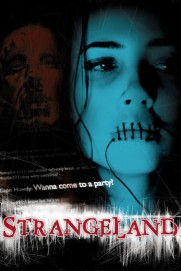

You need only open the inventory proper when you want to combine items, which allows the moment-to-moment gameplay to flow free of frustration. Strangeland also has a handy system that lets you use your scroll wheel to cycle through your inventory items, saving you from navigating through a secondary screen over and over again. Mechanically, there’s your usual point-and-click fare of left-clicking to interact with hotspots and right-clicking to examine them, with an inventory key bringing up your acquired objects and a bar with various menu options pulled down by moving the cursor to the top of the screen. While the smart cursor will alert you to any hotspot when moused over, a highlighter would have helped reduce a bit of pixel hunting with some of the smaller, more concealed objects of interest. One notable example was when I had to pry a metal bar from a structure, but it was so camouflaged that it wasn’t until I happened to mouse over the bar that I realised it was something I could use. Strangeland is an intentionally gloomy place, granted, but the grey-brown hues used throughout most of the game can make it hard to spot objects you’re supposed to interact with. One issue, however, is the muted colour palette used.

Even the menus are animated and noticeably reflect the game’s dark themes, with vials filling with liquid as you hover over different option buttons.

These are animated as well, and one scene of a tear rolling down a woman’s face had me wowed. There’s also a picture-in-picture system at times, where portraits of the relevant characters pop up to give you a closer, more detailed look at them. Animations like walking, moving limbs, and even blinking are all silky smooth, with no jerkiness perceptible, while other small touches such as your character’s hair flopping and bobbing as he moves really add to the immersion. And though it doesn’t appear so at first, everything in this esoteric Giger-esque world – human or machine, living or dead – is connected in some way, and you’ll gradually come to understand how, though never in straightforward ways.Īll this is magnificently rendered in 640x360 pixel art drawn with great skill, though be forewarned that the imagery is very mature, disturbing and downright disgusting in places. Thematically, the grim motifs of decaying-but-living structures, cosmic beings, sacs of disgusting organic matter and dripping things and darkness fit with Strangeland’s surreal trappings. By doubling up with distinctly alternate versions of the same settings, Wormwood have made smart use of the game’s limited locations throughout.Įach area is packed with interesting characters and creatures to discover, like the talking crow-ravens, a creepy old man with no eyeballs who muses philosophically and speaks in riddles, and an anthropomorphic furnace that can help or hinder your efforts. As grotesque as they may seem on the surface to begin with, sometimes you get to see them as they really are when the scenes shift to an even more thoroughly distorted version of reality. Locales are what you’d expect from a circus-gone-wrong scenario: dilapidated tents, broken rides, sinister clowns. There are a handful of locations to explore that offshoot the main tent, and you will backtrack through them frequently in Strangeland’s five-ish hours as you complete puzzles that unlock new things in old places. This is something you’ll be doing often because there’s a lot that can harm you in this world, and each time you die you rematerialise in the hub area again. It wouldn’t be a carnival without circus tents, and the first one you come across happens to have a giant clown head above its door-a living clown head that makes a joke each time you pass through the tent’s doors. Who you and the woman are becomes a mystery to unravel, and destroying the Dark Thing, a shadow-monster living atop the highest point of the carnival, becomes your main objective in this pursuit. Waking on a floating island in what can only be described as an abstract, twisted carnival dreamscape called Strangeland, you take control of a confused, dishevelled man with no memory who witnesses a woman fall to her death in a well. It’s a polished, well-written, well-acted and intriguing interactive nightmare that is easily worth your time-if you can stomach the unrelenting depressive tone and disturbing imagery.

Unlike their earlier postapocalyptic sci-fi adventure, Strangeland is a surrealist, psychologic horror adventure that feels like it was drawn by H.R. Wormwood Studios made an impressive debut in 2012 with Primordia, so expectations were high for their long-awaited follow-up, and it does not disappoint.


 0 kommentar(er)
0 kommentar(er)
